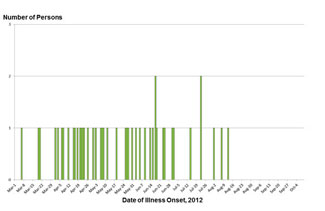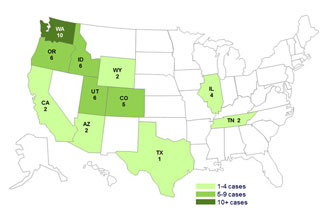Introduction
CDC collaborated with public health and agriculture officials in many states and the U.S. Department of Agriculture’s (USDA) Animal and Plant Health Inspection Service, National Poultry Improvement Plan, and Veterinary Services to investigate an outbreak of human Salmonella Hadar infections linked to chicks, ducklings, and other live poultry from Hatchery B in Idaho. The mail-order hatchery was not named at the request of state authorities. Public health investigators used the PulseNet system to identify cases of illness that were part of this outbreak. In PulseNet, the national subtyping network of public health and food regulatory agency laboratories coordinated by CDC, DNA “fingerprints” of Salmonella bacteria are obtained through diagnostic testing with pulsed-field gel electrophoresis, or PFGE, to identify cases of illness that were part of this outbreak.
A total of 46 persons infected with the outbreak strain of Salmonella Hadar were reported from 11 states: Arizona (2), California (2), Colorado (5), Idaho (6), Illinois (4), Oregon (6), Tennessee (2), Texas (1), Utah (6), Washington (10), and Wyoming (2).
Among 45 persons for whom information was available, illness onset dates ranged from March 6, 2012 to August 12, 2012. Ill persons ranged in age from less than 1 year to 78 years, with a median age of 33 years. Fifty percent of ill persons were female. Among 36 persons with available information, 13 (36%) reported being hospitalized, and no deaths were reported.
This particular outbreak appears to be over. However, Salmonella is an important cause of human illness in the United States. More information about Salmonella infections and steps people can take to reduce their risk of infection can be found on the CDC Salmonella Web Page and the CDC Vital Signs Web Page.
It is important to remember that contact with live poultry, including baby or adult birds, can be a source of human Salmonella infections. Always wash hands thoroughly with soap and water right after touching live poultry or anything in the area where they live and roam. Adults should supervise hand washing for young children. It is important for mail-order hatcheries, agricultural feed stores, and others that sell or display chicks, ducklings, and other live poultry to provide health-related information [PDF – 1 page] to owners and potential purchasers of these birds prior to the point of purchase. This should include information about the risk of acquiring a Salmonella infection from contact with live poultry. Additional recommendations are available.
Investigation of the Outbreak
Epidemiologic, laboratory, and traceback investigations conducted by officials in local, state, and federal public health, agriculture, and regulatory agencies linked this outbreak to chicks, ducklings, and other live poultry from Hatchery B in Idaho. The mail-order hatchery was not named at the request of state authorities.
In interviews, ill persons answered questions about contact with animals and foods consumed during the week before becoming ill. Twenty-eight (90%) of 31 ill persons interviewed reported contact with live poultry (e.g., chicks, ducklings, turkeys) before becoming ill. The median time from acquiring baby poultry and illness onset was 23 days, with a range of 4 to 70 days. Live poultry were purchased from agricultural feed stores or direct from the mail-order hatchery. Ill persons reported purchasing live poultry for backyard flocks to produce eggs or meat, or to keep as pets. Twenty-three (88%) of 26 ill persons with available purchase information reported purchasing live poultry from various locations of 19 different agricultural feed store companies in multiple states. Because the potential for Salmonella infection exists wherever these live poultry are sold, and not just at one feed store, CDC’s recommendations apply wherever these poultry are sold.
Findings of multiple traceback investigations of live poultry from homes of ill persons have identified Hatchery B in Idaho as the source of chicks and other live poultry. The owners of the mail-order hatchery are working closely with public health and agriculture officials to address the outbreak. Hatchery B is a participant in the USDA National Poultry Improvement Plan program. This program is intended to eliminate certain strains of Salmonella that cause illness in poultry breeding flocks and hatcheries, but does not certify that these poultry are free from other strains of Salmonella that may cause human illness.
Live poultry infected with Salmonella can appear healthy and clean, but still shed Salmonella germs that can make people sick. Because live poultry from Hatchery B may live in backyard flocks for long periods of time, it is important to be aware of the risk of Salmonella infection from these birds, as well as all live poultry, and to follow the Advice to Consumers.

